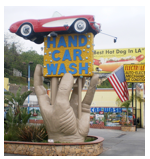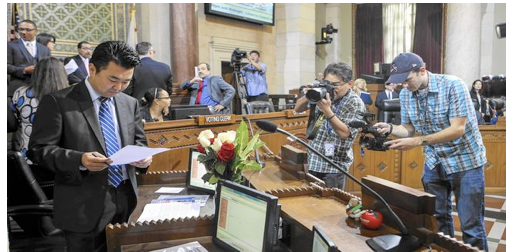CommentsTHE CITY--Neighborhood activists scored a rare victory recently at LA City Hall when lawmakers reversed their prior approval of a 252-unit townhome/condo project that critics say was part of a backroom deal cooked up by former councilman Tom LaBonge and a project that exemplified the city’s immoral practice of allowing residential projects to be built in freeway-adjacent ‘Black Lung zones.’
Critics say LaBonge pulled a fast-one in his final days in office in 2015 when he secured City Council support for Studio City businessman Behzad “Ben” Forat’s building project in the Cahuenga Pass, next to the Hollywood Freeway, while failing to notify affected communities of the developer’s plans.
According to Hollywood Hills resident Orrin Feldman, “there was nothing that looked or smelled right about this project” or LaBonge’s handling of it. “It was a bad-land use project and it was done in the dark,” said Feldman, a member of the Hollywood Hills West Neighborhood Council (HHWNC).
 Yet until recently Forat, owner of a Studio City car wash business, looked to have his development project sewed up. He had the blessing of the councilman of the district – LaBonge. And he had a March 18, 2015 12-0 council vote that set in motion the general plan amendment and zoning and height district changes that were needed before he could build a 252-unit project on his 8.1-acre parcel at 2864 Cahuenga Blvd.
Yet until recently Forat, owner of a Studio City car wash business, looked to have his development project sewed up. He had the blessing of the councilman of the district – LaBonge. And he had a March 18, 2015 12-0 council vote that set in motion the general plan amendment and zoning and height district changes that were needed before he could build a 252-unit project on his 8.1-acre parcel at 2864 Cahuenga Blvd.
But City Hall’s blessing for the project began to unravel when Carolyn Ramsay, LaBonge’s long-time aide and hand-picked successor, was defeated in her bid to succeed her boss (two Forat-related ventures contributed $700 each to Ramsay on March 20, 2015, two days after the council voted to okay Ben Forat’s 252-unit project). (Campaign contribution report below.)
The project’s fortunes went further south when the HHWNC last September – in a 16-0 vote - demanded that Councilman David Ryu, who defeated Ramsay to become LaBonge’s successor, reverse the council’s prior approvals of Forat’s project. (Photo above: Councilman Ryu in council chambers.)
Forat’s plans finally collapsed last Friday (April 1) when Ryu– seven months after the HHWNC requested it – mustered enough council votes to rescind its prior approvals. The vote was 10-2 with Councilmen Mitch O’Farrell and Felipe Fuentes opposing.
“Councilman Ryu did the right thing,” said Feldman, who with fellow HHWNC member Daniel Savage, spearheaded HHWNC’s fight to undo LaBonge’s handiwork. HHWNC in its resolution of opposition said, “The proposed [Forat] project, if built, could have immense negative impacts, including causing traffic gridlock, straining infrastructure resources, and compromising the existing east-west wildlife corridor(s) across the Santa Monica Mtns.”

Jill Stewart, campaign director for the Neighborhood Integrity Initiative, the proposed ballot measure to put the brakes on irresponsible development projects, applauded the work of HHWNC’s board members. “They won a big fight because of their tenacity,” said Stewart. “Unfortunately their victory is the exception, not the rule, at City Hall.”
“One-off projects - like this one - that provide special favors to a developer are approved daily at City Hall, and it’s exactly these kinds of ‘spot-zone’ developments that the Neighborhood Integrity Initiative would stop,” Stewart added.
“The Forat project was not only bad planning, it was immoral planning,” added Stewart, noting that medical experts have warned for years that freeway-adjacent residential projects, like the Forat project, posed serious health risks in particular for young children living in such buildings.
Since 2007 UCLA scientists have warned city officials against allowing residential projects to be sited in what have been called Black Lung zones that are adjacent to freeways. In addition, in 2003, the state legislature banned the future construction of public schools within 500 feet of freeways after hearing experts testify that the super-fine particulate matter generated by traffic on heavily traveled routes can cause lung diseases and brain damage to young children.
“Unfortunately, City Hall still hasn’t learned the lesson that building in Black Lung zones is immoral,” said Stewart. “Yes, the Forat project was stopped – but others like it are still in the pipeline getting ready to be approved by the city. This practice shows just how crazy and immoral our city planning system has become.”
Stewart said at least seven freeway-adjacent projects – with 4,000 units - are in the pipeline right now to be approved by the City Council. “That’s just what is being proposed,” said Stewart. “We’re still trying to identify all the freeway-adjacent projects that have already been built since these risks were known.”
Stewart said the Forat project is one more example of why voters should support the Neighborhood Integrity Initiative.
“Our initiative is meant to give the public the opportunity and the tools needed to shape their local community plans so future development is sustainable, healthy and smart, so that developers can’t use their clout to push through their special interest projects and so projects can’t be built in a Black Lung zone,” said Stewart. “If the public had more say in the planning system than the developers projects like this condo project on the 101 freeway would never get approved, much less built.”
Opponents called the vote Friday a test - but not the only one - of Ryu's campaign pledge that he would not be beholden to developers.
During his council election race, Ryu pitched himself as a City Hall outsider. His hallmark pledge was that he would not accept campaign contributions from developers – this in a city where the real estate industry lavishes big bucks on lawmakers.
According to city records, persons who have self-identified themselves as working in the real estate industry have contributed $5.9 million to candidates for city office since Jan. 1, 2000 to the present. That number does not include the army of land-use attorneys, lobbyists and public relations firms that contribute to city politicians and work for developers.
As the Forat project hit one snag after another, Forat’s attorney sent a letter to Council President Herb Wesson warning that his client would seek at least $300,000 in damages from the city if lawmakers reversed its approvals of the project.
Forat is a flamboyant businessman with a long record of clashing with City Hall about the controversial signage he has used to advertise his car wash business, including a mural and a giant hand holding up an automobile.
If it’s any foretaste of what’s to come, Forat’s prior disputes with City Hall were long and occasionally litigious. And, when the dust settled in those controversies, Forat emerged the winner; both the mural and giant hand still stand.
Maybe Forat’s also lucky. Former Mayor Villaraigosa believed so. In fact, Villaraigosa said he made a ritual of visiting Forat’s car wash as a “good luck charm” on election days when he was on the ballot. Villaraigosa also effusively praised Forat as a “great American” because he gave free car washes on election days to motorists who proved they had voted.
(John Schwada is a former investigative reporter for Fox 11 in Los Angeles, the LA Times and the late Herald Examiner and is the Communications Director for the Neighborhood Integrity Initiative. He is a contributor to CityWatch. His consulting firm is MediaFix Associates.)
-cw
















